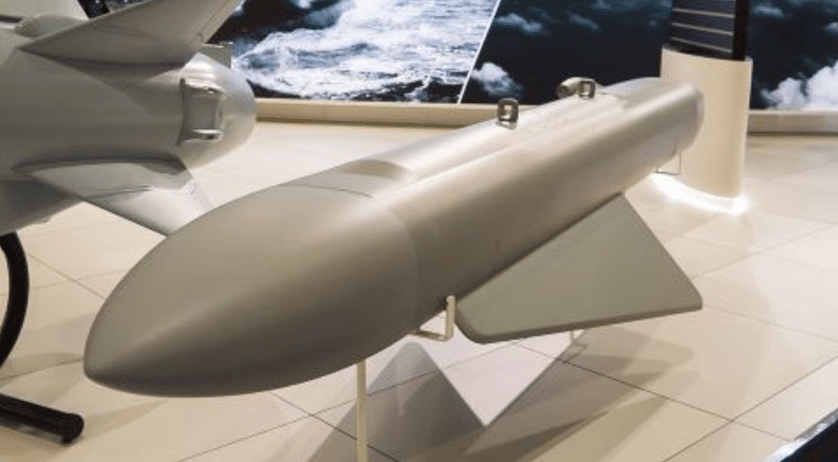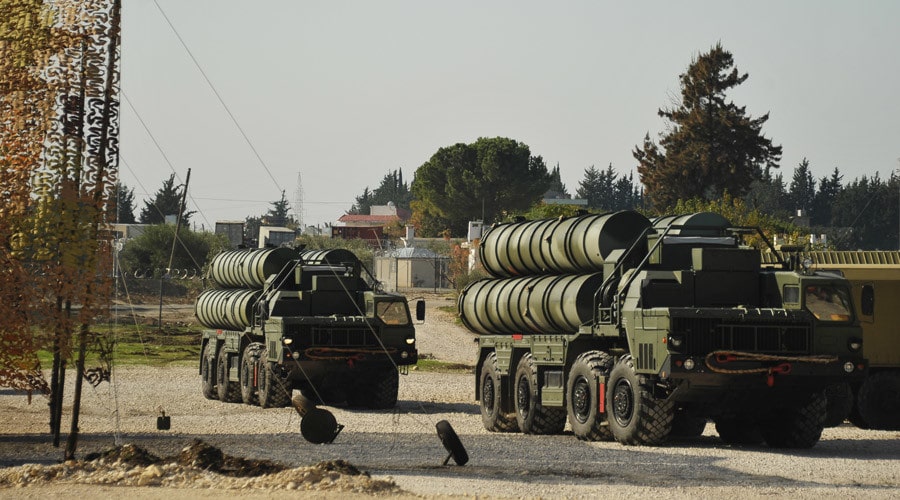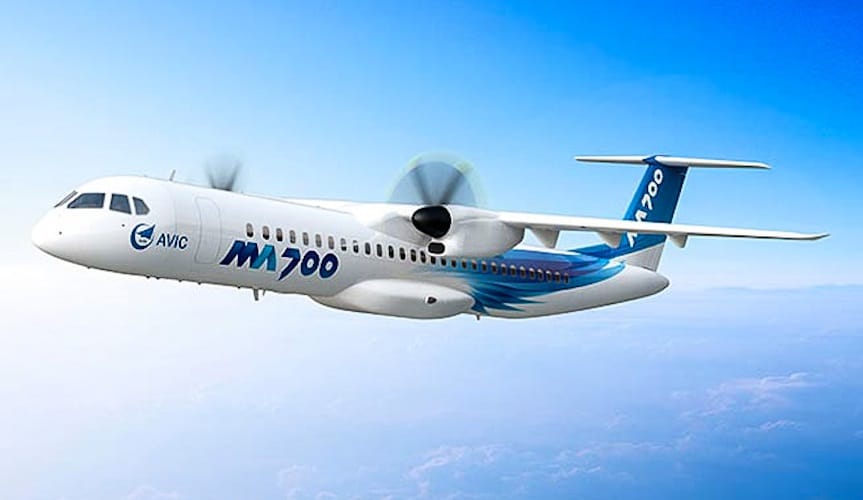3043Views 14Comments

Saab launches Arexis electronic warfare suite for Gripen E/F
At DSEI 2017, Saab launched the Arexis electronic warfare (EW) suite for fighter aircraft, including Saab’s own JAS-39E/F Gripen multi-role fighter.
In its official press release, Saab says that the Arexis is in the final stages of development and will form a new family of EW solutions in Saab’s product portfolio. Saab claims that the Arexis “will be one of the most advanced EW systems installed in a fighter aircraft.”
The Arexis comprises of gallium nitride (GaN)-based active electronically-scanned array (AESA) transceiver modules (TRM) that serve as ultra-wideband DRFM [Digital Radio Frequency Memory]-based jammers and “interferometric direction finding systems.” Saab added that the Arexis will also be available for electronic attack (EA), in which case the Arexis will be enclosed into an external pod.
As an integrated solution, the Arexis functions other contemporary EW/ECM (electronic countermeasure) solutions. It comprises of a radar warning receiver (RWR), enabling the equipped fighter with situational awareness of enemy radar tracking activity. It also includes DRFM-based ECM systems for jamming against enemy radars, be it onboard enemy aircraft or air-to-air missiles (AAM). For dedicated EA roles, the Arexis can be packaged into a pod, which Saab states, “provides high output power” for dedicated EW/EA roles.
Notes & Comments:
Contemporary EW/ECM suites already utilize AESA-based TRMs – examples include the Italian vendor Elettronica and its Virgilius and EDGE, or Turkey’s Aselsan and its HEWS. However, Saab has advanced the approach further by incorporating GaN-based TRMs, thus leveraging recent advances in AESA TRM cooling and power-output (which it has implemented on the Erieye and Giraffe). Saab is offering the Arexis as both a standardized solution for fighter platforms and a dedicated solution for dedicated EW/EA roles.
Saab’s messaging for the Arexis, particularly its use for intelligence, surveillance reconnaissance (ISR) may suggest an effort to achieve sensor fusion onboard the JAS-39E/F by having the Arexis and the Raven ES-05 AESA radar provide situational awareness of the combat environment. With Saab owning its own land and airborne early warning and control (AEW&C) radar technologies, the sensor fusion element will feed the Gripen E/F from native off-board sensors.



14 Comments
by Steve
Sounds like a great system. I wonder if that is available for sale outside of Gripen sales. If India goes for F16 it may be possible. We could get it for Block III. Don’t like the bloody Indian factor in every sale from the West. Why don’t they mind their own business, and stop interfering with Pakistan.
by Bilal Khan
The PAF will likely source the Block-III’s AESA radar and integrated EW/ECM suite from the same source (to achieve a similar goal: sensor fusion). In all likelihood, this will be from China.
However, a complementary set for electronic attack (EA) via an external pod (for stand-off jamming) could potentially be sought from another source. Non-ITAR solutions such as the Saab Arexis, Elettronica EDGE or Aselsan MEHPOD could be the leading options.
by A.P.Singh
Good progress by SABB. Let DRDO and SABB to work after selection of fighter for IAF. Conditions for joint development and transfer of technology must be clearly laydown.Hope darft Will be checked no other than Ex Defense Minister. thanks
by Steve
As a platform Block III will not be a match for Rafale or even Su-30. The electronics (EA) with DRFM at BVR will have a large bearing on outcome of any conflict. We may do well to invest money in this area to level the playing field a bit. We will need really high quality for reasons above, and should be prepared to pay for it, including integration costs and agreements. Remember we will also soon have S-400 to contend with.
by ali amanat
Brother INDIAN interference is not new but how we couter or deal it agressivelly, also PAF should avail the all opportunities other than china including SWEDEN AND ITALY as long as our local AESA radar is not final for PAF future figher plateforms , western systems may be costly but proven and battle tested especially the ITALIAN ONE .
by Omar Dar
I think it’s not just about the money. Pakistan did purchase the Mirage 3 and F-16 when they were practically brand new, and the Pakistani economy was even smaller.
It looks like everything on this front is affected to a large scale by politics. If the Indians go for an American planes, there is a chance that SAAB might be more amenable to selling this to Pakistan. The opposite can also happen, and so all of this carries a risk. Although, the technology does look enticing, the Chinese have to prepare for the full might of America and so I’m sure their technology will not be too far behind.
With regards to the contest between SU-30/Rafales and the JF-17, there is no doubt that the Indian fighters are much larger and more powerful. But the Rafales are too few in number and can be handled by the F-16, while the SU-30’s capabilities are redundant at the short ranges an Indian-Pakistan conflict is likely to occur. So we are well covered by the PAF.
by Omar Dar
I do wonder why India thinks the West will just hand over their technology to them. In fact, I just read elsewhere that the. American companies bidding for the new tenders want control of their proprietary technology even if they assemble it in India.
So it will be just like the SU-30 and T-90 local production. India will build the jets from scratch, but somehow it will still have to import parts to keep them airworthy.
by bill
Sir I doubt that our F16s in current condition are capable to counter Rafael. Even 36 Rafaels shall be challenge with latest BVRs and HOBs along with other gadgets i.e Aesa, IRST and other capabilities. Meanwhile our F16s at best having BVR and WVR at least one generation behind that of Rafael. Similalry having no AESA/IRST. May be they shall be capable in network centric environment but for short span of time. The key is to never go for economy in case of JF17 block III and at least it should have gadgets near yo Rafael if not equivalent. That’s pretty much achievable if only we are ready to bear the cost.
by Omar Dar
I mentioned the F-16 because I read in a very respected publication that our block-52 jets are a match for the Rafales. It also said that defenders need a minimum of 2-1 ratio to cover its airspace. That is why India had to order a minimum of 36, which it needs as a defender to counter the 18 block-52 jets Pakistan possesses. This was also the main reason why the USA stopped the F-16 delivery under immense pressure from India.
The thing to remember is that India is still a third world country, and while it has a stronger economy, it is shockingly incompetent in managing its resources. That is why you read reports of their IL-76 fleet flying in an unairworthy state, the IAF pilot-to-cockpit ratio falling below critical levels and the new m-777 howitzer blowing up due to faulty ammunition.
So the point is that, while we might be poorer, our enemy allows us to cover that through its own blunders. The JF-17 jets, appropriately upgraded, are more than capable of handling the IAF in the hands of our pilots and we don’t need to break the bank to match their shiny gadgets.
by Dar...
SAAB has an interesting corporate strategy. They purposely focus on states seeking military industrial autonomy. “Made in India” would be music to SAAB’s ears.
Why? What their marketing spokesman said in London last week is true. “SAAB don’t just send blueprints”. They actually do develop technologies and capabilities within the host country from the ground up. What’s the corporate advantage in this? They are doing the industrial version of gene splicing. Sure it’ll be “Made in India”, …and forever after share it’s ‘DNA’ with SAAB and Sweden. Clever.
They’re trying the same ruse on a “Made in America” obsessed Trump Administration. SAAB are offering to build 100% of their (and Boeing’s) jet fighter trainers in America, even every last SAAB component. Imagine just how many supply chains SAAB would integrate with then. They’d become as ubiquitous as hot dogs. It’s worked for them in South Africa.
Their electronic warfare pod is very attractive. It’s designed to counter stealth and low frequency systems. SAAB would be an open door to push on for integration with platforms other than Grippen.
All good stuff, …but Vikings don’t always invade by jumping out of longships. Sometimes they slip in through the tradesman’s entrance.
by Bilal Khan
Honestly, if I were PAC I’d ask to get the Saab 2000 revived, and then have it co-produced in Pakistan. Launch orders can be had by tapping into Pakistan’s commuter aircraft market and by crafting special mission ISR aircraft for the armed forces and government.
by Jigsaw
There will be some transfer of technology nevertheless owing to the potential magnitude of the deal – to have Indians be able to assemble those jets locally. But critical technology will never be shared. In essence, India will not be able to use that technology to feed Tejas or AMCA or any other platform of their own. Technology transfer agreements are strictly tied to local manufacturing of the jet they choose – legally and technically both.
by Dar...
There’s considerable logic to your suggestion. This is the astute methodology to employ to acquire and establish valuable industrial networks that accrete substantial technological and political gains.
Pakistan already operates the SAAB 2000, (Saudi Arabia too? If they still have an interest in this platform they could fence off American obstructiveness to it’s further development). There are additional airframes available from civil markets that don’t involve SAAB directly, (perhaps General Motors still have some corporate legacy they’d like to sell?)
By developing this naval recon air platform Pakistan can leverage SAAB (for electronic systems), and Short’s (for fuselage tech because they built the rear fuselage of the 2000), and by usual business networking Short’s parent Bombardier, (who currently loathe the USA because of Boeing, so potentially significant mileage to be made there). Possibly Rolls Royce too, (for engine tech, if Pakistan sourced their SAAB 2000 engines from RR?).
Such industrial relationships then help strengthen state relationships, in this case potentially not just with old friends like the Saudi’s, but also with Sweden, the UK, and Canada. Three countries currently very keen to develop international industrial relationships. All potentially from just one airframe. A lot of potential gain and good will from relatively little expenditure.
This is exactly how Western states and their military industrial complexes operate. They integrate quietly, but substantially, on ‘under the radar’ projects. This builds both corporate and state relationship confidence and inter-dependence for locally politically significant numbers of jobs. Then they leverage those networks and accreted experience for more substantial activities.
This is a significantly wiser strategy than brash strivings for frankly unachievable, indigenous industrial autonomy. Such autonomy is impossible even for military industrial complexes like the USA, so why aim for fantasy?
Russia can be autonomous if she has too, but always seeks to avoid this outcome, because autonomy is another form of isolationism, which leads inexorably to stagnation.
Absolute state industrial autonomy, like “Made in India/America”, as a long term strategy model is ultimately actually very unattractive to both business and politics at an international level and can leave a state very isolated and ultimately technologically out of touch. If other country’s industries aren’t allowed to wet their beaks their respective states stop their back-room academics from sharing too, that can be almost impossible for the isolationist to recover ground from.
by Omar Dar
Firstly, our F-16s do have bvr capability in the form AIM-120 missiles. Even the JF-17 is equipped with SD-10 which is a bvr missile.
Secondly, not having IRST and HOBS is not the end of the world. Fighters like the MIG-21 still have air defence value in spite of not having any advanced capabilities and so are still serving by the 1000s.
Our F-16s can counter the new Indian jets and our JF-17 can ably support it. In fact, the PAF is in a much better position with the JF-17 being inducted, while the IAF is still stuck with expired junk like the MIG 21 and the LCA Tejas still not out of testing.